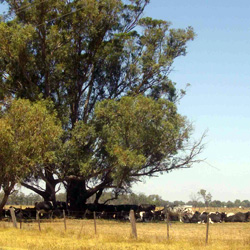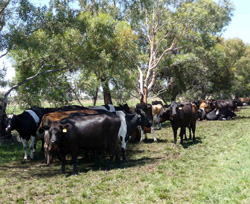Cattle shelter guidelines

Section 9 of the Prevention of Cruelty to Animals Act 1986 defines cruelty offences and requires that proper and sufficient shelter is provided for animals.
Healthy cattle can tolerate a wide range of temperatures if they are acclimatised and have adequate feed and water. Good shelter can improve the welfare of the animal and reduce production losses. Cattle without shelter need to put more energy into normal functioning and less into production.
Cattle should be provided with shelter in times of high and low temperatures. This can minimise the impact of climatic extremes and prevent suffering or possibly death. The amount of shelter provided should be sufficient for all cattle to access it at the same time.
Managing cattle in heat

Cattle lose heat primarily by respiration (from moist tissues in the respiratory system) as well as through transference of heat into the air and by evaporation of water from sweat.
Providing shelter enables cattle to shade from direct sun, reducing the extra heat load they take on by up to 50 per cent. Heat stress and exhaustion should not occur if cattle are able to find shade and rest during the hottest part of the day.
It has been shown that cattle prefer shade over water in hot conditions and will spend more time resting and less time chewing their cud as the ambient temperature increases.
Cattle at highest risk of heat stress
Animals at highest risk of heat stress include:
- overfat stock
- young cattle
- dark coloured cattle
- high producing dairy cows
- sick cattle or cattle that have previous history of respiratory disease.
Reduced appetites of cattle in extreme heat
Appetite is reduced during extreme heat and can result in decreased daily weight gains and feed efficiency. Provision of good quality, highly palatable feed and plenty of shelter during periods of hot weather will reduce the heat load of the cattle and assist in maintaining normal feed intakes.
Any new feed should be gradually introduced to reduce the risk of acidosis or metabolic disease.
Dairy cattle under heat stress
A study on the economic effects of heat loads on dairy cattle production in Australia has shown that extreme heat has the following effects on dairy production:
- reduced milk yield
- reduced milk fat and protein percentages
- lower first service conception rates
- lower calf birth weights
- larger number of services per pregnancy.
The effect of extreme heat was more pronounced for high producing cows, and resulted in reductions of up to 461 litres of milk per cow per year on farms that did not provide shade for their herds.
A further study found that milk production was 3 per cent greater for shaded cows than for unshaded cows.
More information about heat stress in Australian dairy herds can be found on the Dairy Australia website.
Cows and their calves
Research also shows a higher mortality rate in calves subjected to heat stress in their first week of life. Cows may be observed trying to shade their calves and it has been shown that cows will actively seek sheltered areas in which to calve.
Artificially reared calves must have access to shelter in hot weather with natural air flow important for cooling of the environment.
Shelter suitable during hot weather
The best type of shelter during extreme heat protects cattle from the sun and allows for the cooling effect of the wind. Some options for shelter in hot weather are:
- constructed shelters using materials such as shade cloth, corrugated iron or timber
- shadebelts – these are usually a single line of deciduous trees, planted in an east-west direction to give shade on the south side
- trees with large canopies —- planted individually in fields
- shelterbelts — thick hedges of trees usually fenced off from stock.
Water
The importance of clean fresh water during periods of extreme heat should not be underestimated. As a general rule dairy cattle drink somewhere in the range of 120 to 150 litres of water per day when producing about 20 litres of milk. This requirement can increase by as much as 80 per cent on days over 35ºC.
Water sources should be:
- familiar to cattle before an extreme weather event
- be close to shelter
- be of sufficient volume to cope during periods of peak demand.
The number of watering points and water flow should be increased if a large number of cattle are kept together.
Managing cattle in cold weather
Wind chill and rain may reduce the animal's effective temperature to below its critical level, resulting in a decrease in weight gain and milk yield and increases in milk fat. For high risk animals the outcome may even be death.
Cattle at highest risk of cold stress include:
- newly born calves and calving cows
- cattle in low body condition
- sick cattle.
Appetite is stimulated by cold temperatures, and cold stress increases an animal's requirement for energy to maintain body temperature and functions.
Studies suggest that a yearling's energy requirement may increase during an extreme winter event.
Where cold stress is likely, providing shelter and increasing the availability of highly digestible and palatable feed will assist cattle to maintain normal body temperature and production — minimising the effects of cold stress.
Shelter for calving cows
Special shelter management may be necessary for calving cows and their calves. If required, small paddocks within a sheltered area along the edge of shelterbelts are useful.
Close regular observation should be carried out and any cow found down and unable to stand should receive appropriate treatment and be provided with shelter or be moved carefully to a sheltered area. Extra feed may be required to help the cow meet her own metabolic needs as well as the nutritional needs of the calf.
Calves in cold weather
Calves are most at risk during cold weather due to their small size. They need to have good shelter provided, as even strong and healthy calves can die if exposed to adverse weather.
Decreasing temperature and increasing precipitation on the day of calving increases mortality, and calves born to heifers are particularly susceptible to adverse weather conditions.
Additionally, cold stress has been shown to decrease the rate of absorption of colostrum in newborn calves — compromising their immune system and contributing potentially to morbidity and mortality.
Pens used for rearing calves should have a draught-free covered area to protect calves from the elements, and paddocks should have shelter accessible to all calves.
Shelter suitable for extreme cold
The following forms of shelter are suitable for cattle:
- constructed wind breaks
- natural undulating paddocks and gullies
- shelterbelts
- trees — planted in a north-south direction to protect from north and south westerly winds.
Sheds (open on one side) erected in paddocks can afford protection from wind.
Temporary shelter can be provided in the form of shade cloths or plastic tarpaulins if other shelter is not available.
Shelterbelts
Shelterbelts are the best form of shelter against wind, with the 'shelter zone' spanning a distance about 14 times the height of the trees. If wind speed is reduced, cold stress is markedly reduced.
The trees forming the shelterbelt should be spaced evenly and be semi-permeable in order to slow the wind without creating turbulence. Under-planting should be incorporated to prevent the wind being funneled through gaps at livestock level.
Shelterbelts should be thinned evenly to allow wind flow. Planting them in an east-west direction provides shade during the hottest part of the day.
Shelter close to water
Care should be taken when placing shelter near water so it does not result in cattle camping around the water source, causing overcrowding and preventing cattle from accessing water.
The number of watering points or water flow as well as the amount of available shade should be sufficient for the number of cattle and be increased if a large number of cattle are kept together.
Sick cattle in extreme weather
Cattle in poor conditions (including cattle coming out of a drought), sick cattle or those with a history of respiratory disease are especially vulnerable to the extremes of weather, and should be housed separately from the main mob to ensure preferential access to shelter and feed and expedited treatment. Without appropriate shelter these animals may die from the impact of adverse weather conditions.
Moving cattle already under stress requires care and planning so it needs to be done well before an extreme weather event, to prevent further aggravation of the animal's condition.
Cattle injured due to fire or flood
Cattle that have been injured in a natural disaster such as fire or flood need protection from the elements as they will be especially sensitive to the extremes of heat, sun or cold.
Cattle prone to sunburn
Stock showing signs of photosensitivity (sunburn) must have access to shade. Preventative measures are available for some types of photosensitivity, including facial eczema. Sunburnt stock will also benefit from veterinary treatment.
Feedlot cattle
Feedlot cattle should be protected from extreme adverse weather conditions causing cold stress, heat stress or excessive heat load. Feedlot staff and management must be aware of the climatic conditions and the clinical signs in cattle that are associated with heat stress.
Feedlots must have in place plans for minimising the impact of hot and cold weather and dealing with heat and cold stress.
In relation to heat stress, the provision of shade or alternative means of cooling such as sprinklers and fans may be required.
In these conditions, cattle should be constantly monitored for:
- signs of restlessness
- decreased food intake
- congregating or huddling around water troughs
- cessation of rumination — which would indicate thermal load stress requiring immediate preventative action.
Where cold stress predominates, shelter and allowance for additional nutrient requirements should be provided.
Shelter in holding yards
When cattle are in holding yards, use should be made of artificial and natural shade to protect them from extremes of wind, heat and cold.
Shelter is important for young cattle (especially calves under two weeks of age) if they are left in yards for longer than two hours before transport and loading.
Heat stress in dairy cows standing in the holding yard can be reduced with the use of sprinklers and the provision of shade during hot and humid weather.
More information
For more information about the welfare of cattle please consult your private vet or local Animal Health staff via our Customer Service Centre on 136 186.
Further information and resources to help you deal with heat stress in Australian dairy herds can be found on the Dairy Australia website.